Quick studies and daily sketching, even for just 15 minutes, dramatically improve artistic skills. Artists practice essential strokes—hatching, stippling, scribbles—while varying pressure and direction to create diverse textures. Timed exercises, from 30 seconds to 5 minutes, train the eye to capture a subject’s essence without getting lost in details. Setting specific goals for each session helps overcome creative blocks and builds confidence. These short, focused practices open the gateway to artistic growth that many never discover.
Key Takeaways
- Quick studies lasting 15 seconds to 30 minutes help artists capture the essence of subjects without getting lost in details.
- Daily sketching routines of just 15 minutes build consistency, confidence, and reveal growth patterns in artistic development.
- Practice essential mark-making techniques like hatching, stippling, and scribbling to develop muscle memory and create varied textures.
- Gesture drawing exercises train artists to capture movement and energy through loose, flowing strokes rather than precise details.
- Timed exercises combat perfectionism, overcome creative blocks, and encourage focusing on the big picture rather than minute details.
The Power of Quick Studies in Artistic Development
A surprising truth about artistic mastery lies in the power of quick studies. Artists who regularly practice these speedy sketches transform their ability to see the world around them! In just 15 seconds to 30 minutes, they learn to capture the essence of a subject without getting stuck on tiny details.
Quick sketches build confidence like nothing else—artists become braver with their brushstrokes and more willing to play with wild colors and textures. These zippy practice sessions help transform complex scenes into simple shapes, making all artwork more efficient.
The best part? These studies become a treasure chest of real-life observations, recording colors and feelings that fuel bigger paintings later on.
Movement, gestures, and spontaneity flow naturally when speed matters more than perfection!
Essential Strokes and Mark-Making for Sketchers
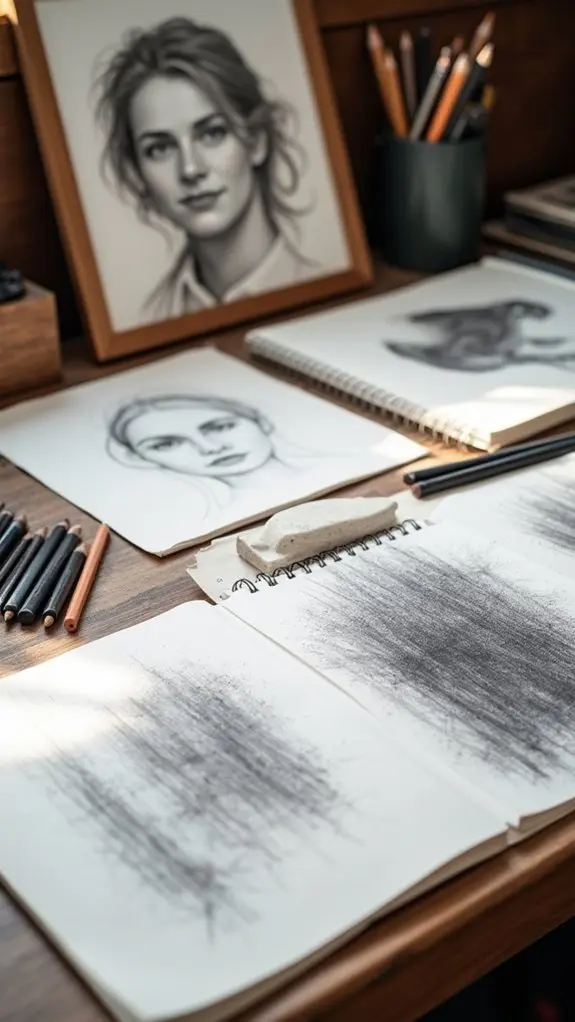
While quick studies teach artists to capture the big picture, the language of making marks holds the key to artistic expression. Essential strokes like hatching, stippling, scribbles, and chicken scratches form an artist’s vocabulary, allowing them to “speak” visually in different ways.
Practice makes perfect! Daily sessions focusing on one stroke at a time help build muscle memory, turning these marks into second nature. Artists can play with spacing, direction, and pressure to create wildly different effects. It’s like learning the ABC’s of drawing!
Line work isn’t talent—it’s persistent practice! Fifteen minutes daily transforms scratchy marks into confident artistic language.
The real magic happens when combining strokes. Layer some hatching over stippling, and boom—you’ve got unique textures that bring sketches to life!
Mastering these fundamental marks doesn’t just improve line quality; it helps artists truly capture what makes their subjects special.
Building Your Daily 15-Minute Sketch Routine
Fifteen minutes of daily sketching creates a powerful rhythm that transforms hesitant marks into confident, expressive lines over time.
Artists who combine structured practice of specific techniques—like hatching or contour drawing—with exploratory free sketching build a balanced skill set that grows surprisingly quickly.
This consistent, focused approach turns occasional drawing into a genuine artistic practice, helping even busy beginners see real improvement within weeks rather than months or years.
Consistency Creates Progress
Dedication transforms ordinary sketches into remarkable art through the power of daily practice. Artists who commit to quick drawing sessions see their skills dramatically improve over time, even when they practice for just 15 minutes daily.
- Consistency turns hesitant strokes into confident, natural lines.
- Daily practice builds muscle memory that makes sketching feel effortless.
- Two-minute focus on a single technique creates surprising versatility.
- Tracking progress reveals growth patterns that might otherwise go unnoticed.
- Short, manageable sessions fit into even the busiest schedules.
When artists stick to their routine, those 15-minute blocks add up fast! The brain starts to recognize patterns, hands become steadier, and suddenly, what seemed impossible becomes second nature.
It’s like magic, except it’s not—it’s the awesome power of showing up day after day!
Mix Focused Techniques
Every artist can transform their daily practice by mixing focused techniques into a powerful routine. The key is blending line quality exercises—like continuous line drawing—with quick scenery studies that capture the essence of complex scenes.
Each day, try spending two minutes on one stroke type, varying pressure and direction to create lively, fluid lines before switching to observational skills practice.
Mixing pen or pencil techniques helps artists discover new approaches to light and dark contrasts. These simple exercises, when practiced every day, build a strong foundation for drawing and painting.
The benefits of quick studies are enormous: just 15 minutes of focused practice can dramatically improve your ability to capture lines and shapes!
Come back to these studies one day to marvel at how they’re silently developing your artistic voice while creating stunning progress.
Gesture Drawing: Capturing Motion in Seconds
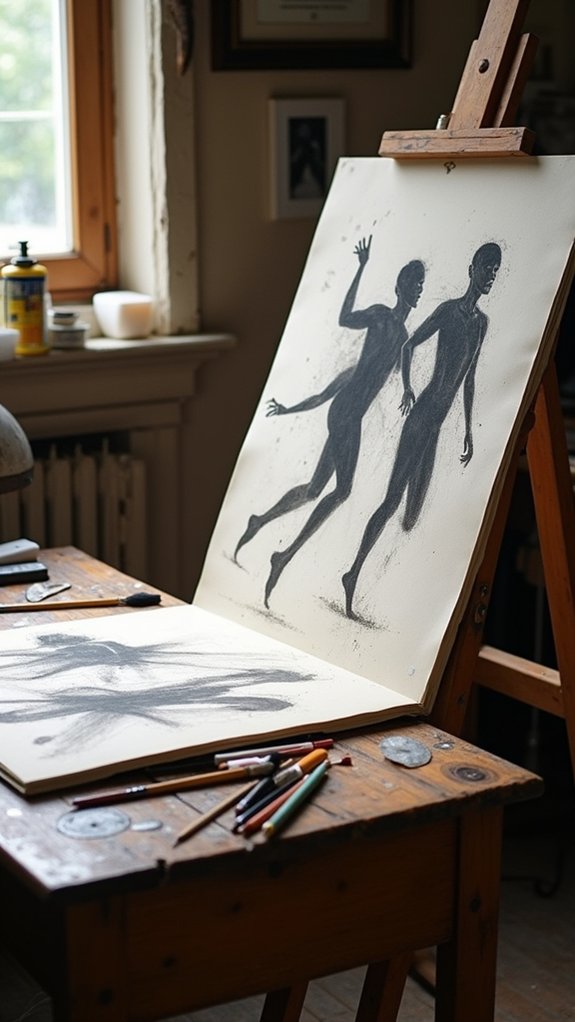
Gesture drawing releases the power of dynamic energy lines, turning quick sketches into expressive snapshots of movement.
Artists can start with super-quick timed gesture exercises, beginning at just 30 seconds per pose and gradually building up to 5 minutes as their confidence grows.
These lightning-fast drawings train the eye to catch the essential action and feeling of a subject, rather than getting stuck on tiny details that don’t matter in the big picture.
DYNAMIC ENERGY LINES
Motion comes alive on the page when artists use dynamic energy lines in their sketches. These flowing marks capture the movement and essence of a subject, creating drawings that virtually leap off the paper.
Energy lines form the backbone of effective gesture drawings, communicating action in just seconds.
- Start with loose, sweeping strokes that follow the subject’s main action line
- Focus on the “flow” rather than perfect proportions or details
- Use curved lines for natural movement and sharp angles for dramatic action
- Vary line weight—pressing harder for core movements and lighter for secondary motions
- Practice with quick 30-second poses before attempting longer studies
TIMED GESTURE EXERCISES
Releasing the artist’s potential begins with mastering timed gesture exercises, a powerful method for training the eye and hand to work in harmony. These quick sketches, typically lasting between 1-5 minutes, focus on capturing movement rather than details. Artists learn to see the whole before the parts!
Gesture Variations keep practice sessions fresh and challenging. Try drawing people rushing to work, athletes mid-jump, or even fidgety pets! The goal isn’t perfection—it’s speed and essence. Many artists complete 10-20 sketches in one sitting, building unstoppable confidence with each attempt.
This technique works like artistic cardio, pumping up observation muscles and breaking the fear of blank pages. The magic happens when artists stop overthinking and just draw, letting their pencils dance across the paper!
Basic Shapes as Building Blocks for Complex Art
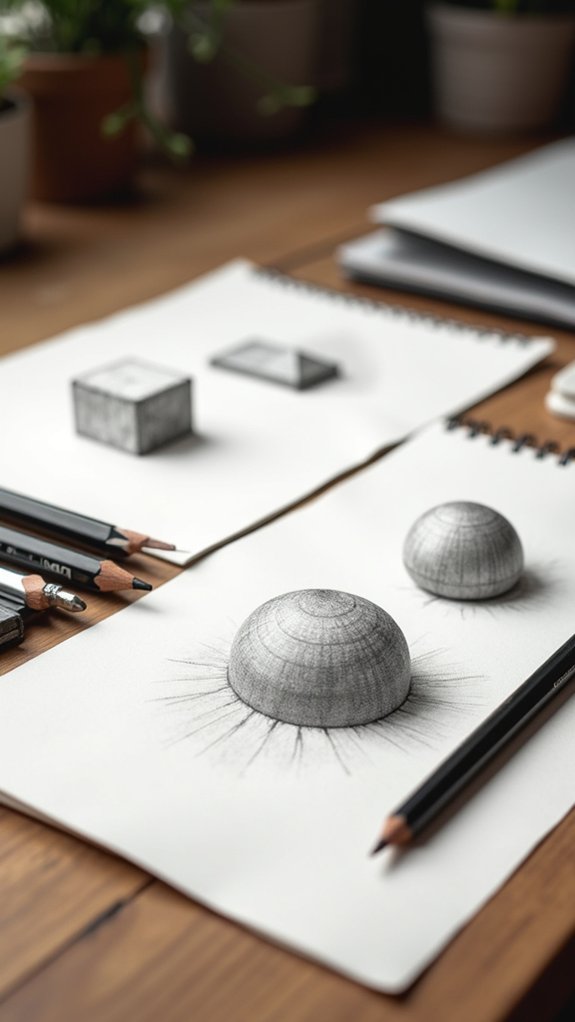
Building blocks of creation, basic shapes serve as the secret foundation for all spectacular artwork. Artists who master circles, triangles, and squares gain access to drawing anything!
Shape exploration isn’t just boring practice—it’s like building artistic super-powers that make complex drawings suddenly seem possible.
- Drawing basic shapes over and over builds essential muscle memory
- Different sizes and pressures create amazing depth and texture
- Breaking down complex objects into simple shapes makes hard stuff easy
- Practicing shapes from different angles boosts your perspective skills
- Mastering basic forms creates a springboard to artistic freedom
Think of shapes as the ABCs of art. Just like you needed to learn letters before writing essays, artists need shapes before creating masterpieces.
It’s not magic—it’s method!
Texture Studies: Creating Depth With Simple Techniques
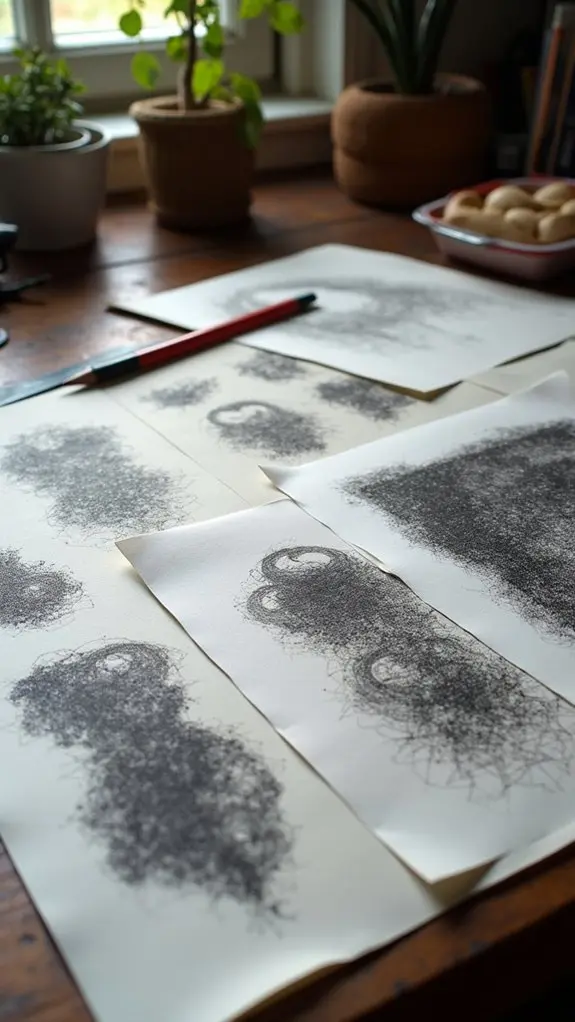
Creativity explodes when artists discover the power of texture in their sketches! By practicing different Texture Techniques like hatching (parallel lines) and stippling (tiny dots), artists can transform flat drawings into works with amazing depth. It’s like magic!
Try pressing your pencil with different amounts of pressure—light touches create soft, cloudy textures while pushing harder makes bold, dramatic effects. Isn’t that cool?
Quick sketches of tree bark, wrinkly fabric, or bumpy rocks help train your eyes and hands to capture what makes each surface unique.
The real secret? Mix it up! Vary the size and spacing of your marks, and layer different strokes on top of each other. Soon you’ll create textures so realistic, people will want to reach out and touch your drawings!
Timed Exercises to Break Perfectionism
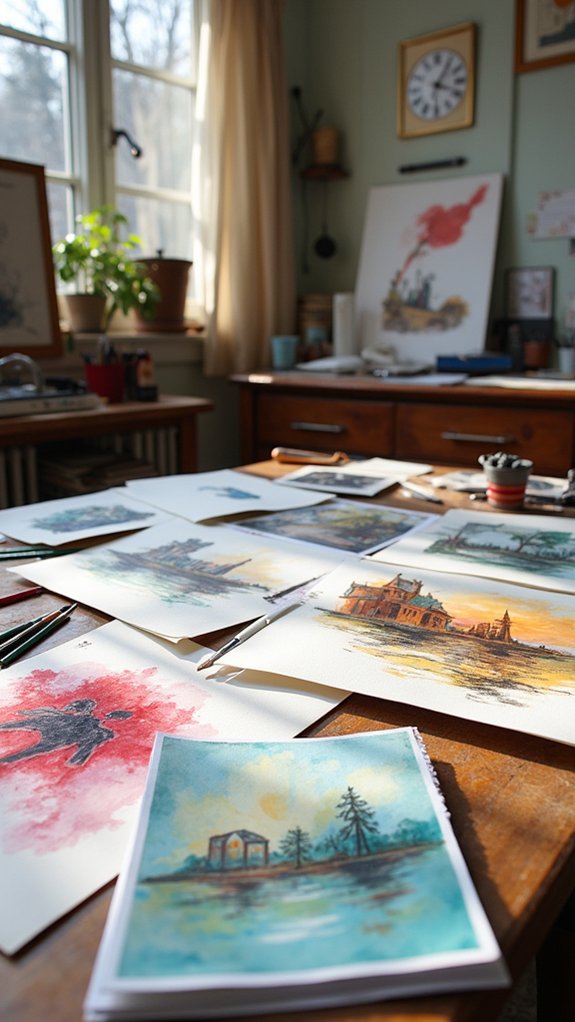
Timed exercises, often called “speed sketching,” break the chains of perfectionism that hold many artists back from their true potential.
Setting a timer for just a few minutes forces artists to focus on capturing the big picture instead of obsessing over tiny details that don’t really matter.
When we rush against the clock, something magical happens – our natural creativity flows more freely, and we discover new ways of seeing the world that careful, slow drawing might never reveal.
Breaking Speed Barriers
Many artists find themselves trapped in the sticky web of perfectionism, spending hours fussing over tiny details while losing sight of their original vision. Breaking speed barriers through timed exercises can be a game-changer!
These speed techniques force artists to capture just what matters most, without getting bogged down.
- Set a timer for just 1-5 minutes to sketch a subject
- Focus on capturing the essence rather than perfect details
- Practice daily to build confidence and reduce fear of mistakes
- Challenge yourself to gradually reduce drawing time
- Use different tools (thick markers, charcoal) that discourage nitpicking
As artists practice these quick studies regularly, they’ll notice their observational skills improving dramatically.
The brain learns to identify key features faster, and hands become more fluid with each timed session—creating art that feels alive and energetic!
Freedom Through Limitations
While speed sketching opens new doors, imposing limits on your art process might sound strange at first—but it’s actually the secret to greater freedom!
Creative constraints, especially timed exercises ranging from 15 seconds to 5 minutes, force artists to abandon perfectionism and focus on capturing a subject’s essence instead.
When the clock is ticking, artists can’t fuss over tiny details. This time pressure creates a more fluid, spontaneous style that feels wonderfully liberating! Regular practice with these quick sketches helps artists develop the ability to quickly assess movement and form.
These timed challenges encourage wild experimentation with different techniques and materials. Best of all, working under time constraints teaches artists to embrace mistakes as valuable parts of the creative journey, turning “oops” moments into opportunities for growth!
Choosing the Right Materials for Quick Sketching
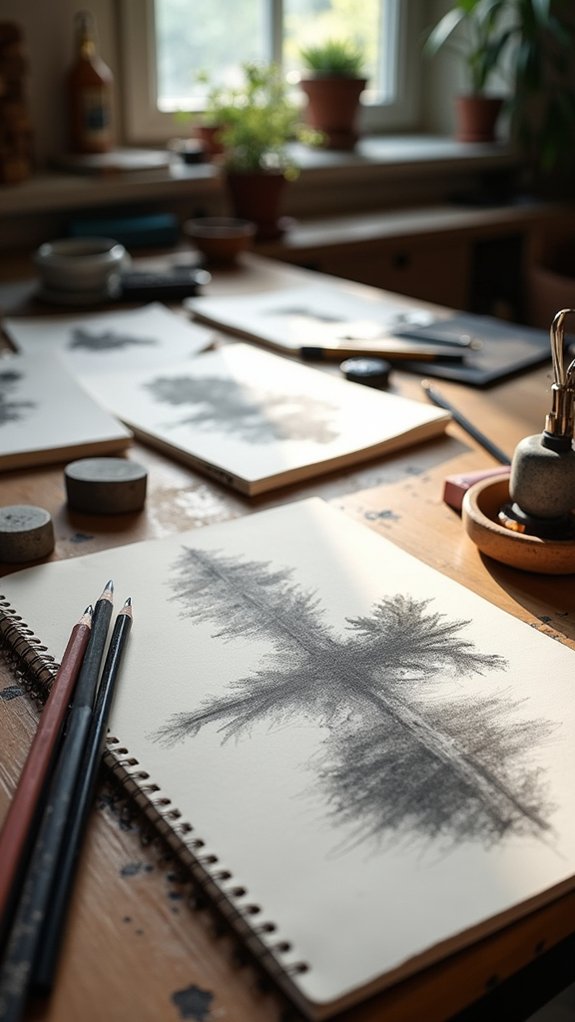
Quick sketching begins with selecting tools that won’t slow down the creative process or interrupt the flow of ideas. Material selection is essential – the right supplies can make your practice sessions fun, productive, and inspiring!
Artists need equipment that responds instantly to their touch, allowing them to capture fleeting moments before they disappear.
- A portable sketchbook keeps all your ideas in one place, ready whenever inspiration strikes
- Soft pencils (2B-6B) create those juicy, expressive lines that make sketches come alive
- Charcoal makes bold, dramatic marks—perfect for capturing shadows and light quickly
- Ink pens with medium tips give clean, permanent lines that won’t smudge or fade
- Digital tablets offer the ultimate flexibility—draw, erase, and experiment without limits
Contour Drawing: Training Your Eye-Hand Coordination
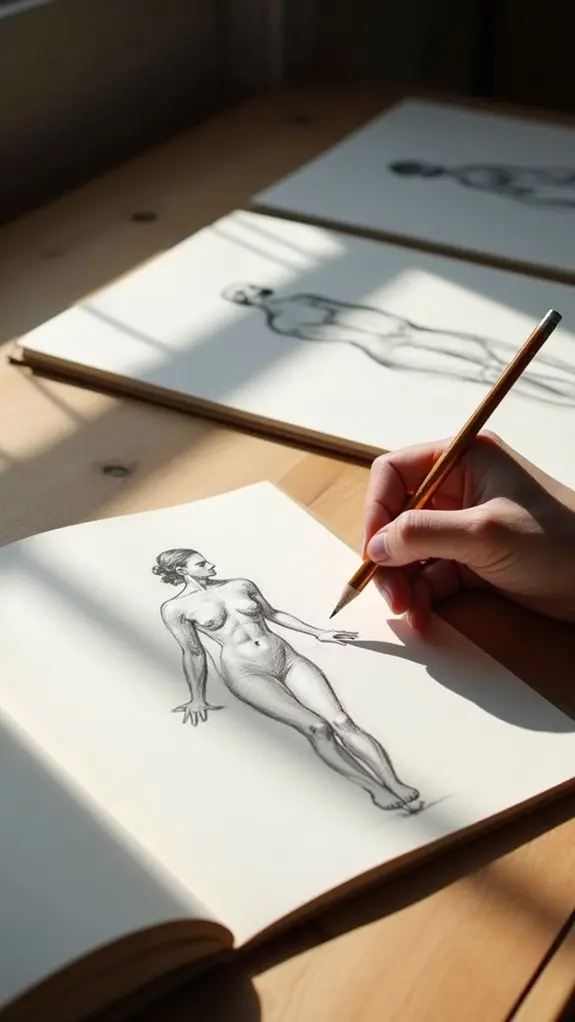
With the right tools in hand, artists can now focus on developing a critical skill: contour drawing. This technique challenges artists to create continuous line drawings without lifting their pencil from the paper, forcing them to really see their subject’s edges and shapes. Contour Exploration isn’t just fun—it seriously boosts your eye-hand coordination!
| Benefits | Beginner Tips | Advanced Practice |
|---|---|---|
| Improves observation | Focus on edges | Try blind contour |
| Builds confidence | Draw slowly | Add timed sessions |
| Enhances fluidity | Don’t erase | Combine with shading |
Regular practice makes capturing forms quicker and more accurate. The best part? There’s no pressure to be perfect! Since contour drawing emphasizes expression over details, it’s the perfect warm-up before tackling more complex artwork.
Sketching Different Subjects: People, Objects, and Landscapes
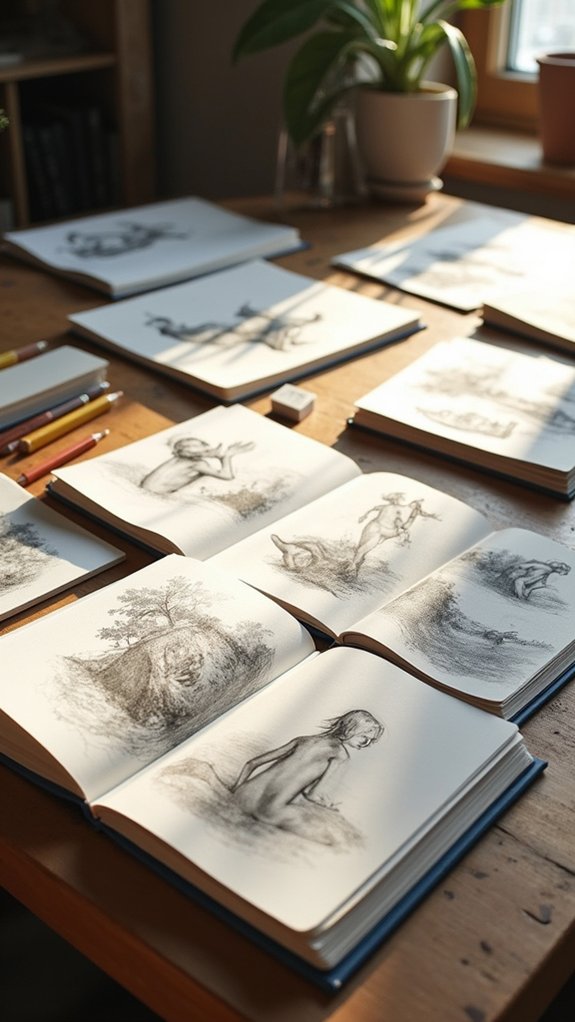
Artists can master different subjects through focused practice techniques that build core skills.
When sketching people, capturing the flow and energy of movement matters more than perfect details, while objects become easier to draw when broken down into simple shapes first.
Scenery sketching brings another challenge altogether, requiring artists to create depth through careful placement of elements in the foreground, middle ground, and background.
Capturing Human Movement
Many successful artists consider movement the lifeblood of compelling figure drawings. Capturing movement dynamics requires practice and specific techniques that train the eye to see and the hand to record motion quickly.
Artists develop this skill through regular practice sessions that focus on the essence rather than details.
- Timed gesture drawing sessions (as short as 30 seconds) train artists to capture action over perfection.
- Sketching people in public spaces helps observe natural poses and transitions between movements.
- Starting with simple stick figures establishes proper proportions before adding details.
- Daily practice improves hand-eye coordination and builds muscle memory.
- Studying different body types enhances understanding of how weight shifts during movement.
These techniques help artists develop the intuitive ability to freeze motion on paper, bringing energy and life to their work.
Still Life Fundamentals
While capturing movement brings figures to life, the quiet world of still objects offers its own rich lessons. Artists who regularly practice still life sketching build stronger observational skills by focusing on basic shapes and forms in a controlled setting. Textural Exploration becomes a fascinating journey as artists learn how different surfaces interact with light!
| Object Type | Benefits | Quick Tips | Mediums to Try | Skills Gained |
|---|---|---|---|---|
| Fruit/Food | Basic forms | Use simple shapes first | Charcoal | Proportion |
| Glass Items | Transparency | Focus on reflections | Ink | Light effects |
| Fabric/Cloth | Folds and draping | Notice shadow depth | Pencil | Texture mastery |
| Metal Objects | Shine and highlights | Contrast is key | Colored pencil | Reflections |
| Natural Items | Organic shapes | Capture essence quickly | Mixed media | Natural forms |
Quick sketches help artists master perspective while building confidence—perfect for discovering your unique style!
Landscape Line Techniques
The vast expanse of natural scenery offers endless possibilities for artists who wish to capture its beauty through line work.
Scenery Dynamics come alive when artists break down complex forms into simple shapes, creating vivid scenes that pop off the page. The secret lies in how different line techniques can transform a blank page into a breathtaking vista!
- Start with basic shapes to map out the composition—mountains become triangles, rivers become curvy lines.
- Use hatching (parallel lines) and cross-hatching (criss-crossed lines) to add awesome shadows and textures.
- Try quick sketches of moving elements like birds or flowing water—it’s super fun!
- Mix up your line weight—thick lines for foreground, thin lines for background.
- Practice from real life or photos to nail those tricky light effects.
Community Challenges to Boost Your Practice Motivation

When artists find their motivation waning, community challenges can provide the perfect spark to reignite creative passions. Challenge engagement through popular events like Inktober or Draw This In Your Style offers structured prompts that push artists beyond their comfort zones. These daily exercises become exciting adventures rather than tedious tasks!
Online art groups create supportive spaces where participants can share their progress, get helpful feedback, and marvel at others’ interpretations of the same prompt. The amazing thing about these communities? They build accountability through shared experiences. When someone notices you missed a day, they’ll check in!
Themed challenges nudge artists to explore unfamiliar subjects and techniques they might otherwise avoid. This collective journey transforms solitary practice into a fun, social experience where everyone grows together.
Color Experimentation in Quick Studies

Quick color studies offer artists a perfect playground for experimentation without the intimidating commitment of larger projects.
These short exercises unleash creative freedom while building essential skills in Color Dynamics. Artists discover how colors talk to each other on paper, often leading to happy accidents and breakthrough moments!
- Limiting your palette to just 3-4 colors forces you to really understand how they mix and blend.
- Broad, bold brushstrokes in quick studies help capture mood rather than fussy details.
- Trying different mediums (watercolor one day, acrylics the next) reveals unique color behaviors.
- Testing color theory in 15-minute studies shows how light changes everything.
- Quick studies become treasure maps to your artistic growth, showing what techniques work best for you.
From Quick Sketch to Finished Piece: The Evolution
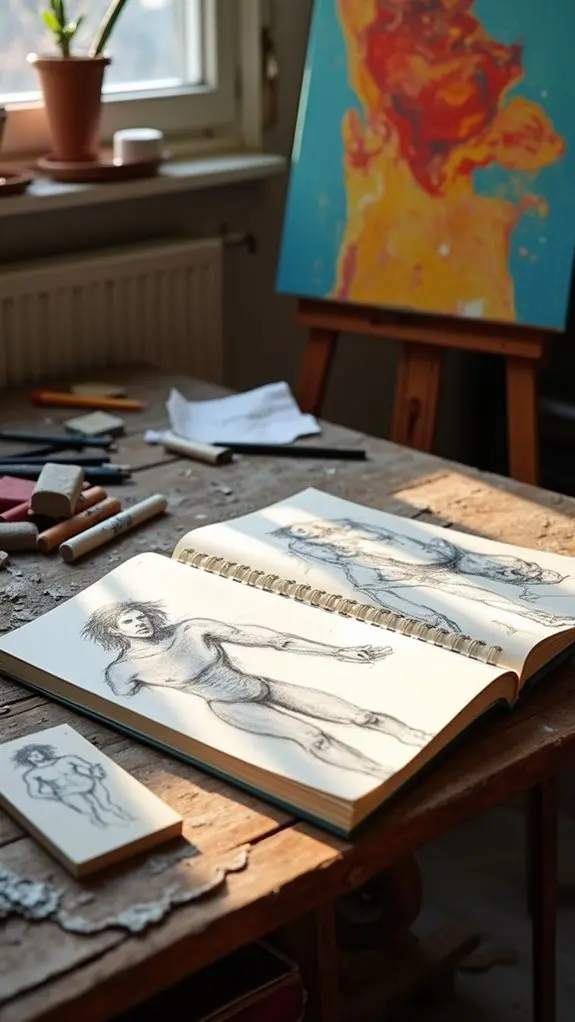
How exactly does a simple pencil sketch transform into a breathtaking masterpiece? The journey from quick study to polished artwork is like watching a butterfly emerge from its cocoon.
Artists begin by capturing essential elements in fast sketches—maybe just 30 seconds long—focusing on movement and basic shapes.
In those fleeting half-minute sketches, artists capture the soul of their subject—pure movement and foundational forms emerge before details intrude.
This Sketch Evolution isn’t random! Before diving into detailed work, smart artists review their quick studies, picking out the strongest ideas and most exciting gestures.
These speedy drawings reveal insights about light, texture, and composition that become the backbone of the final piece.
The magic happens when artists transfer what they learned about color, form, and brush techniques from their experiments into a more refined, intentional creation—turning those initial, energetic scribbles into something truly amazing!
Overcoming Creative Blocks Through Regular Practice
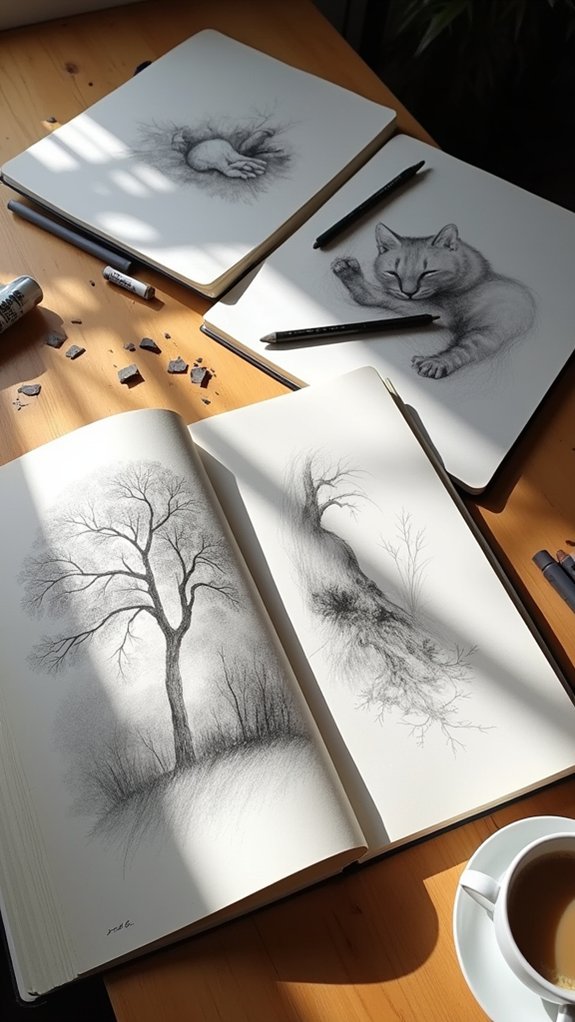
Every artist faces that dreaded moment—staring at a blank page while creativity seems miles away. Developing a positive creative mindset is key to pushing past these blocks.
The solution? Regular practice, even just 15 minutes daily!
- Set specific goals for each session (like “today I’ll focus on drawing hands”)
- Try quick 30-second sketches to break perfectionist tendencies
- Practice in short bursts—creativity isn’t an endless well!
- Join art communities for motivation and fresh perspectives
- Embrace mistakes as stepping stones, not roadblocks
Frequently Asked Questions
How Can I Improve My Art Techniques?
Technique Exploration involves establishing daily practice routines, experimenting with various strokes and materials, engaging in timed exercises, and conducting regular self-critiques to identify areas requiring further development.
What Is the Concept of Quick Sketching?
Quick sketching captures a subject’s essence through rapid execution, prioritizing dynamic movement over detail. It trains artists to observe effectively and record fundamental forms in just seconds to minutes.
What to Draw to Improve Drawing Skills?
To improve drawing skills, artists should practice basic shapes, engage in timed drawing exercises, sketch dynamic subjects, experiment with textures, and incorporate warm-up routines focusing on fundamental techniques.
How Many Hours Should I Practice Sketching?
Ideal practice frequency varies individually. Research suggests 15-30 minutes daily is more effective than occasional marathon sessions. Consistency builds neural pathways better than duration alone when developing sketching skills.
Conclusion
Regular sketch practice transforms ordinary artists into exceptional ones. Quick studies build muscle memory, train the eye to see details, and develop essential skills without the pressure of perfectionism. By dedicating just 15 minutes daily to these exercises, artists create habits that fuel creativity and overcome blocks. Remember, every master artist started with simple strokes and basic shapes—your artistic journey grows one sketch at a time!


Leave a Reply